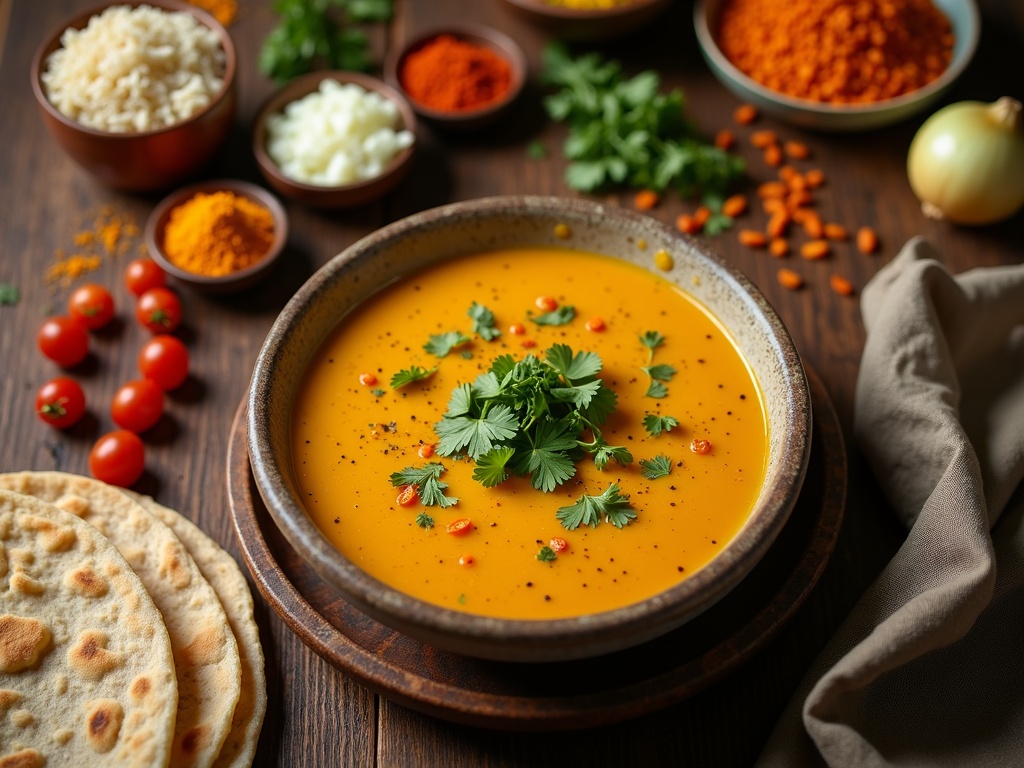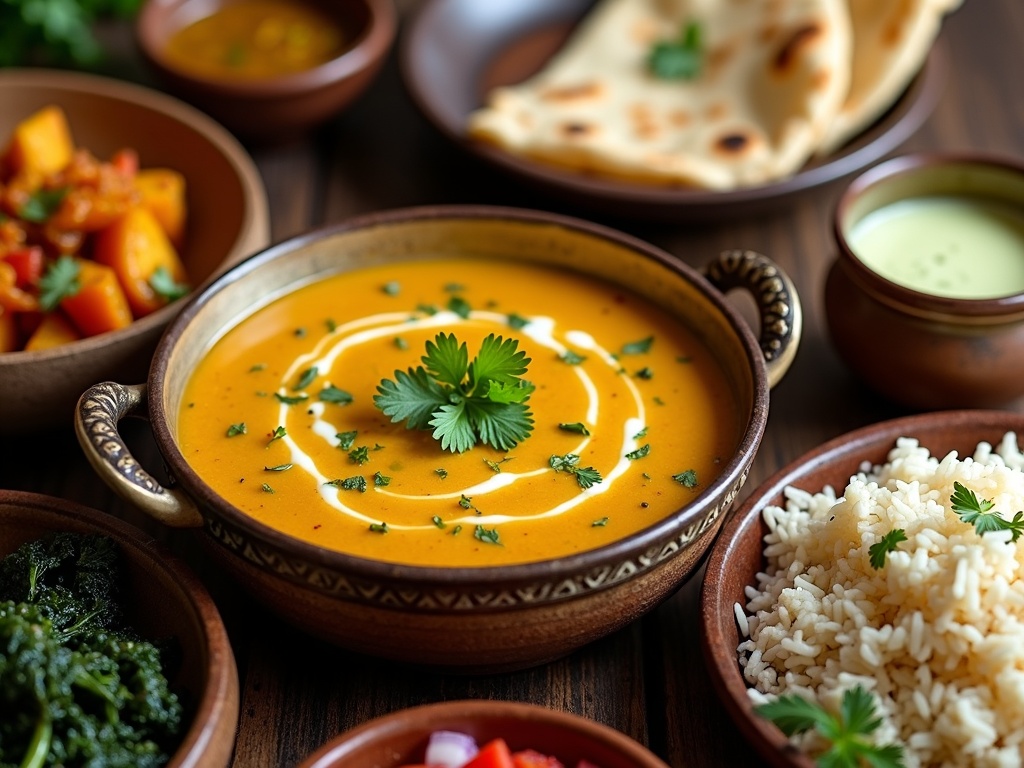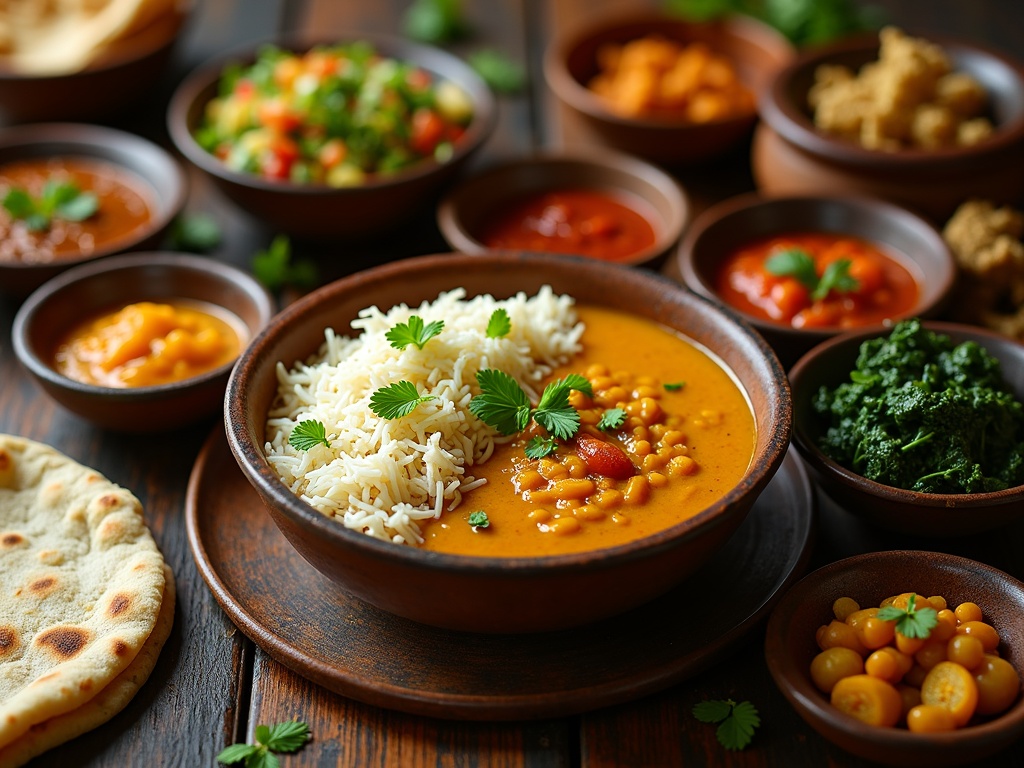Dahl recipe, a lentil-based dish packed with protein and fiber, offers remarkable nutritional benefits while adapting easily to different cooking methods and regional flavors. This versatile superfood can be prepared using stovetop, pressure cooker, or microwave techniques, making it perfect for both quick weeknight meals and relaxed weekend cooking.
Find In This Article
Key Takeaways
- A standard serving of dahl provides approximately 18 grams of protein and 15 grams of fiber, supporting muscle maintenance and digestive health.
- The basic dahl recipe requires simple ingredients: red lentils, onions, garlic, ginger, tomatoes, and key spices like turmeric, cumin, and coriander.
- Cooking methods vary from traditional stovetop simmering (30-40 minutes) to quick pressure cooker preparation (10-15 minutes) depending on available time.
- Regional variations like Dal Tadka, Dal Makhani, and coconut-infused Southern Indian versions offer diverse flavor profiles to explore.
- For a complete Indian meal, pair dahl with rice or flatbreads, add chutneys or pickles for contrast, and include vegetable sides for nutritional balance.
The Health Benefits That Make Dahl a Superfood
Dahl isn’t just a tasty comfort food—it’s packed with nutrients that earn it superfood status. I’ve found that incorporating this lentil-based dish into my weekly meal plan has made a noticeable difference in my overall health and energy levels.
Impressive Nutritional Profile
The nutritional density of dahl is what makes it stand out from other plant-based dishes. A single cup of cooked red lentils contains approximately 18 grams of protein, making it an excellent choice for muscle maintenance and repair. As someone who follows an active lifestyle, I’ve come to rely on dahl as a protein source that doesn’t come with the saturated fats found in many animal proteins.
The fiber content in dahl is equally impressive. With around 15 grams per serving, it supports digestive health in multiple ways:
- Promotes regular bowel movements and prevents constipation
- Feeds beneficial gut bacteria for improved immunity
- Creates a feeling of fullness that can prevent overeating
- Helps stabilize blood sugar levels by slowing digestion
I’ve noticed that on days when I eat fiber-rich dahl curry for lunch, I don’t experience the mid-afternoon energy crashes that used to plague me.
For those watching their weight, dahl offers the perfect combination of being filling while remaining low in fat. With just about 2 grams of fat per serving, it satisfies hunger without adding excessive calories. I’ve incorporated it into my eating plan when I need to maintain my weight without feeling deprived.
Dahl also delivers an impressive array of micronutrients. The iron content supports healthy blood cell production, while B vitamins contribute to energy metabolism. The potassium in lentils helps maintain proper blood pressure levels, and zinc supports immune function. These nutrients are particularly valuable for those following plant-based diets who might otherwise struggle to get certain nutrients.
I’ve found that pairing dahl with whole grains like homemade chapati creates a complete protein profile similar to what you’d find in animal products. This combination provides all nine essential amino acids our bodies can’t produce on their own.
The beauty of dahl lies in its versatility—it can be adapted to include various vegetables, spices, and cooking methods while maintaining its core nutritional benefits. Whether you’re looking to boost your protein intake, improve digestion, or simply enjoy a satisfying meal that supports your health goals, dahl delivers on all fronts.

Master the Perfect Basic Dahl
I’ve found that a simple dahl recipe is the perfect starting point for anyone looking to explore Indian cuisine. This protein-rich dish uses just a handful of ingredients but delivers incredible flavor that will leave you coming back for more.
The Essential Ingredients
The foundation of a good dahl begins with quality red lentils. I always thoroughly rinse 1 cup of red lentils until the water runs clear to remove any dust or debris. This simple step makes a big difference in the final texture of your vegetable curry companion.
For the aromatic base, I combine:
- 1 finely chopped onion
- 2 minced garlic cloves
- 1-inch piece of ginger, minced
- 2 diced fresh tomatoes
The spice mixture is what transforms simple lentils into something magical. I use:
- 1 teaspoon turmeric powder
- 1 teaspoon cumin seeds
- 1 teaspoon coriander powder
The Cooking Process
I start by heating 2 tablespoons of oil or ghee in a heavy-bottomed pot. Once hot, I add the cumin seeds and let them sizzle for about 30 seconds until fragrant. Next, I toss in the chopped onions and sauté until golden brown, which takes about 5 minutes.
The garlic and ginger go in next, and I cook them just until the raw smell disappears – usually about a minute. Then I add the tomatoes and spices, stirring everything together to create a fragrant base.
After the tomatoes have softened, I add the rinsed lentils and 3 cups of water. This is brought to a boil before reducing to a simmer. The dahl needs about 20-25 minutes to cook, during which time the lentils break down to create that perfect creamy consistency.
I like to serve my dahl with a side of freshly made chapati or over a bed of fluffy basmati rice. For an extra touch of flavor, I sometimes prepare a simple tempering of cumin seeds and dried chili in ghee to pour over the top just before serving.
This basic dahl recipe is completely vegetarian and vegan (if using vegetable oil instead of ghee), making it a versatile dish for any dietary preference.

Quick and Easy Cooking Methods
I’ve found that dahl can be prepared using several techniques, each with its own advantages. Mastering these methods will help you fit this nutritious dish into your busy schedule without sacrificing flavor.
Stovetop Method
The traditional stovetop approach gives you complete control over the cooking process. I start by rinsing the lentils thoroughly, then combine them with water in a 1:3 ratio—one cup of lentils requires three cups of water. After bringing the mixture to a boil, I reduce the heat and let it simmer for 30-40 minutes, stirring occasionally to prevent sticking.
This method allows me to adjust seasoning as I go and monitor the consistency perfectly. The gentle simmering also helps the spices infuse gradually, creating layers of flavor that make traditional vegetable curry companions sing. Though it takes longer, I find the stovetop method ideal when I want to develop deeper flavors.
Pressure Cooker and Quick Options
When time is tight, my pressure cooker becomes my best friend. I use just 2 cups of water per cup of lentils and can have perfectly cooked dahl in just 10-15 minutes. The sealed environment of the pressure cooker not only speeds up cooking but actually preserves more nutrients in the lentils.
For absolute convenience, I sometimes turn to my microwave. Here’s how I make microwave dahl when in a hurry:
- Place rinsed lentils in a microwave-safe bowl with appropriate water
- Cover with a microwave-safe lid, leaving it slightly ajar
- Cook on high for 10 minutes, then stir
- Continue cooking in 2-minute intervals until desired softness
I’ve noticed my rajma recipe techniques apply similarly to dahl—both legume dishes benefit from these time-saving methods. The pressure cooker creates a silky texture that’s particularly nice when serving dahl alongside freshly made chapati.
No matter which method you choose, the key is matching your cooking technique to your available time while ensuring the lentils are cooked through but not mushy. I’ve found each approach has its place in my kitchen, depending on whether I’m preparing a leisurely weekend meal or need a quick weeknight dinner solution.

Explore Popular Dahl Variations
Dahl, a hearty lentil stew, comes in countless variations across South Asia. I’ve found that experimenting with different types opens up a world of flavors that can transform this humble dish into something extraordinary. Let me walk you through some popular variations that will elevate your next meal.
Classic Tempered Variations
Dal Tadka stands as perhaps the most beloved variation, featuring yellow lentils (toor or moong dal) cooked until soft and then elevated with a tempering of spices. I prepare this by heating ghee in a small pan, adding cumin seeds, dried red chilies, garlic, and sometimes asafoetida until fragrant. This aromatic oil is then poured over the cooked dal, creating that distinctive sizzle and infusing it with complex flavors. This technique, called tadka or chaunk, is what gives this simple curry its signature character.
Dal Makhani represents the luxurious side of dahl cooking. This rich, creamy preparation uses whole black lentils (urad) and sometimes kidney beans, slowly simmered for hours. The magic happens when I add butter and cream toward the end, creating a velvety texture that pairs perfectly with naan or rice. The slow cooking process allows the lentils to break down and develop deep flavor profiles that can’t be rushed.
Regional Inspirations
The beauty of dahl lies in its regional adaptations across the Indian subcontinent:
- Southern Indian variations often incorporate coconut milk and curry leaves, creating lighter, more tropical flavor profiles.
- Bengali-style dahl typically includes panch phoron (five-spice blend) and sometimes fish.
- Gujarati dal tends to be sweeter with jaggery and often includes vegetables like carrots or pumpkin.
- Kashmiri preparations might feature fennel seeds and ginger for warming qualities.
Northern Indian dahls tend to be heartier and richer, perfect alongside homemade chapati, while Southern variations often complement rice dishes like vegetable biryani with their thinner consistency and tangier profiles.
Each variation reflects local ingredients and cooking traditions. For instance, spinach dahl (dal palak) combines protein-rich lentils with iron-packed greens, while masoor dal offers a quicker-cooking alternative that still delivers robust flavor.
I’ve found that experimenting with different lentil types—from red masoor to yellow moong to black urad—creates entirely different dishes, each with unique textures and cooking times. The spices you choose further customize these variations, whether you prefer the warming garam masala of the north or the fragrant mustard and curry leaf combinations of the south.
Create a Complete Indian Meal
A perfect dahl isn’t meant to be enjoyed alone. I’ve discovered that transforming this humble legume dish into a complete Indian feast requires thoughtful pairing with complementary sides and accompaniments. The right combinations will elevate your dining experience, creating a balanced and satisfying meal.
Pair with Staple Carbohydrates
Dahl pairs beautifully with traditional Indian carbohydrates that help soak up the rich, spiced flavors:
- 1 cup of cooked basmati rice per person provides the ideal base – the long, fragrant grains complement the creamy texture of dahl perfectly.
- 1-2 pieces of freshly made flatbreads like soft homemade chapati or naan allow you to scoop up every last bit of the delicious sauce.
- For a lighter option, try brown rice or quinoa as healthier alternatives that still pair wonderfully.
I find that serving both rice and a flatbread gives guests options based on their preferences. The rice absorbs the dahl’s flavors while the bread provides a contrasting texture and convenient way to enjoy every last drop.
Enhance with Chutneys and Pickles
Adding condiments brings brightness and contrast to your meal:
- Mint chutney offers cooling freshness against the warm spices.
- Tangy tamarind chutney balances with sweetness.
- Lime pickle adds punchy acidity and textural interest.
- Raita (yogurt-based condiment) provides a cooling effect, especially useful with spicier dahl variations.
These accompaniments aren’t merely optional extras—they’re essential components that create a symphony of flavors on your plate. I always prepare at least two different chutneys or pickles when serving dahl to guests.
Add Vegetable Sides
Incorporating vegetables creates nutritional balance and adds visual appeal:
- Quick sautéed spinach with garlic complements the earthy flavors of dahl.
- Roasted cauliflower or potatoes with cumin seeds add crunch and substance.
- A simple kachumber salad (diced cucumber, tomato, onion with lemon juice) brings freshness.
- Vegetable curry with seasonal produce makes the meal more substantial.
I make sure to include at least one vegetable side that contrasts with the dahl in texture—if the dahl is smooth, I’ll add something with bite or crunch to create interest.
This balanced approach to meal planning transforms a simple dahl into a feast worthy of family gatherings or dinner parties. The beauty lies in how these elements complement each other—the mild, protein-rich dahl serves as the centerpiece while the sides add complexity and nutrition.
For larger gatherings, I expand the menu further by adding a flavorful vegetable biryani or perhaps a hearty rajma (kidney bean curry) for additional protein options. These additions create a true Indian feast that showcases the incredible diversity of flavors in Indian cuisine.
The beauty of building a meal around dahl is its flexibility—you can make it as simple or elaborate as the occasion demands, while still maintaining authentic Indian flavors and traditions.

Sources:
USDA Nutrition Facts for Lentils, BBC Good Food Dahl Recipes, Healthline Nutritional Benefits of Lentils, Food Network Cooking with Lentils, Epicurious Indian Dahl Variations

